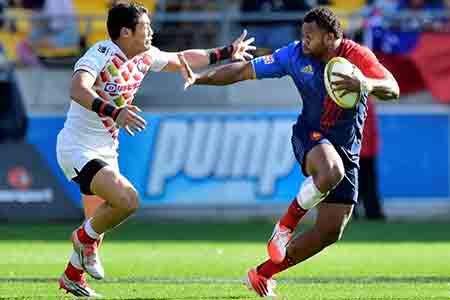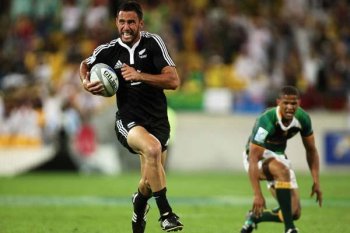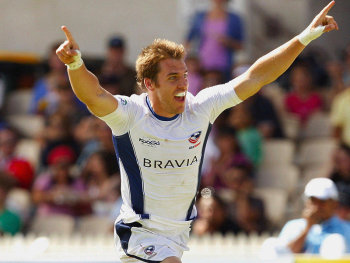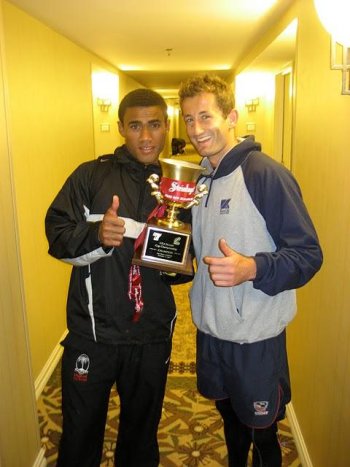Sevens is a game that one can play in any position with reasonable success at the lower levels, but as you progress it becomes a lot more specialized. Some items here are also found in my previous articles on playing prop in sevens, playing hooker in sevens, playing scrumhalf in sevens, and playing flyhalf in sevens, but are important if reading this piece by itself.

What is required to play center?
The center is one of the most powerful runners in the game, with the ability to create opportunities for his/her teammates on attack, or even finish them on their own. Passing well off both hands, excellent vision and decision- making are all keys to success in this position. Speed is also vital – with one
of the most important skills being tackling.
The center could be a flyhalf, center or wing in XVs rugby.
Obviously many of these statements are generalizations, but based on my own experience in sevens.
Kickoffs kicked: In previous articles we have mentioned three different types of kickoffs.
If the kickoff goes deep (near the opposition 22m area) then the role of the center is to ensure the defensive line comes up together, with all six players in a line next to each other. It is important that no one shoots out of this defensive line, otherwise it will create an easy attacking opportunity for the opposition.
If the kickoff is made in the middle of the field (around the 10-15m area) the center can either contest for that ball in the air, or come up together with his/her teammates ready to play offense or defense.
Watch rising sevens power house Australia dominate the London 7s in the video clip below, especially center Brackin Karauria-Henry (number 6), who is exceptional at creating space for his team mates. The first try in this clip comes from retaining a kickoff with the Australians sending it wide. One of the scores (2 minutes) sees center Karauria-Henry create and finish off an excellent try against South Africa, which proved the difference in this final.
Kickoffs received: The center can stand around the 10m area in the middle of the field when receiving a kickoff. In this way he/she can get into an attacking position once the ball is received, by dropping back in depth if a traditional kick to one of the sidelines has been taken.
From there the ball can go wide, unless you are on your own tryline, and opt for a clearance kick. If the kickoff is aimed where the center is positioned, it is important to time the jump into the air to contest for the ball. The team kicking off has a major advantage running onto the ball at speed and thus is able to get higher in aerial battle to contest that vital set piece.
Lineout’s: In the rare situation that a team opts to have four people in the lineout when throwing in, the center can be that fourth person at the back of the lineout. It is important not to be in the actual lineout but a few meters to the side, but still inside the 15m mark. Once the ball is thrown the center can take an overthrow, or planned overthrow. If the lineout is won with the traditional three players, then the center can drop back and play flyhalf on attack.
The lineout is an excellent attacking opportunity, with the opposition being 20m away. Various set moves can be very effective, and if run correctly can be used at any level of rugby.
Here is a rare clip from the 2009 Sevens Rugby World Cup which features New Zealand and Wales in an historic quarterfinal clash. Wales went on to upset the Kiwis and eventually win the RWC title in unbelievable fashion. Despite that, watch both Zar Lawrence (33 seconds) and Lote Raikabula
(both players play center when needed) score excellent tries for New Zealand. Raikabula’s try comes from a lineout (2 minutes 35 seconds) with plenty of space for his teammate to draw two defenders, setting up an excellent try.
Scrums: The scrums are also a great attacking piece, and even if a clean break is not made, a wide ruck is vital for an attacking platform. The center must work very closely with the wing and flyhalf, as it will be up to these three players to secure that wide ruck and send the ball across field.
Working in threes in 7s is one of the core basics of the game. One person is the ball carrier, and when tackled the next player is the rucker, with the third arriving player being the scrumhalf. Unlike XVs rugby, whoever arrives third at a break down automatically becomes the scrumhalf. This pattern leaves four players to attack the rest of the field. Width and depth on attack are other important basics for the remaining attackers. After that, hands up early to catch the ball, and running forward to receive the pass are needed.
Defense: The role of the center on defense is vital as he/she is normally in the middle of the field. From set pieces the goal of the center is to force the opposition to take the ball wide, making the tackle on the opposition center or wing. If the ball gets to the opposition wing, the defenders can use the sideline and squeeze that runner out of bounds with the center making that tackle on the wing, leaving his/her wing free in case of an offload from the attacker.
The center must ensure his/her tackling brings the ball carrier to the ground, setting up a ruck, and allowing the defense to realign. If the ball carrier is able to get an off-load, the attackers have a high chance of slicing through the defensive line. The best centers in the game have the ability to make a
forceful tackle, and then turn the ball over.
Attack:
The center – much like the flyhalf – is a creator of space, exploiting defenders and ultimately scoring or setting up tries for his/her team. Support play is vital, with the center able to get into a great position when the wing or flyhalf breaks free.
Watch in the clip below, 1 minute 12 seconds, in which New Zealand center Zar Lawrence supports wing Kurt Baker and receives the inside pass for a vital score against Fiji.
In the following highlight clip, look at 1 minute 17 seconds, in which South African center Robert Ebersohn delivers a superb pass to set free Renfred Dazel. Then watch 3 minute 50 seconds in which the ever-present Chris Wyles links up with winger Kevin Swiryn to score for the USA. At 5 minutes 13 seconds Australia’s Richard Kingi creates a beautiful try for Shawn Foley, which also seals the match.
Best centers in the world?
Some of my favourite centers of all time include: Zar Lawrence of New Zealand; Chris Wyles of the USA, and Fijian William Ryder. Even though Ryder is not a traditional center, as he plays sweeper on defense, his offensive threat is unmatched.
All of these players have the ability to create scoring opportunities for their teams, or even cross the line themselves. Lawrence and Wyles are super strong on defense, and lead by example in everything they do.

Watch this highlight clip to see New Zealander Zar Lawrence(pictured above) [number 12] in action. For years he has been one of the core members of the New Zealand squad, and has achieved remarkable success in his career. Lawrence is 16th on the most tries scored list with 100 for his country. He also leads the Haka when New Zealand win any of the IRB Sevens tournaments.

Unfortunately there aren’t that many filmed highlights of USA’s Chris Wyles (pictured above) [number 6] in action. During the 2007/2008 season Wyles was one of the main reasons for the success of the North American side. Wyles finished with 26 tries (playing in only 6 of the 8 tournaments) finishing tied 8th on the most tries for the season.
Watch 6 minutes 35 seconds, in which Wyles links up for an excellent score, and helps the USA beat Australia 28-26 in an historic victory.

Watch this highlight clip to see Fiji’s William Ryder (pictured,left) [number 10] in action, using that trademark sidestep of his.
During the 2006/2007 IRB World Series Sevens season Ryder was unbelievable – with many calling him the next Serevi. He scored the most points during that season (416) and amassed an amazing 42 tries. He is currently 13th on the most tries scored sheet with 105.
Are you a center?
Superior strength, decision-making and vision; accurate passing off both hands, and the ability to put people into space are all vital skills.
Add consistency in tackling, and of course general speed, and you have the making of a great center!
published by: RugbyIQ
